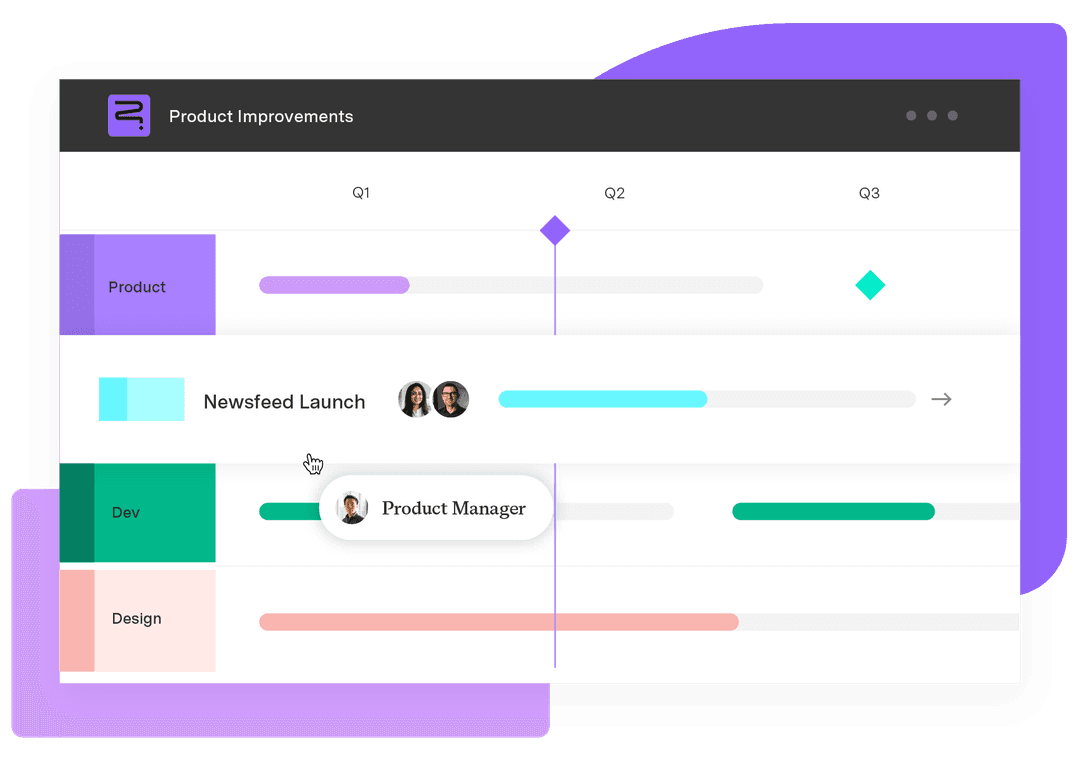Master the new product development process
Tempo Team
New product development (NPD) is an exciting and challenging process, but mistakes are costly. Risks and roadblocks are part of the thrill of shepherding a product idea from the drawing board to an excited user’s hands.
Development teams use a rigorous, systematic process involving research, design, and engineering to avoid missteps and ensure new products meet customers’ needs. This approach, known as the new product development process, guides the team from brainstorming to launch.
Interested in steering an idea through concept, development, and launch? Here’s everything you need to know about how to develop a product.
What is a new product development process?
Businesses engaging in new product development commit resources for months or even years. A cross-functional development group needs a comprehensive, long-term process to help them communicate and remain focused over extended timelines.
A new product development process offers a structured framework to ensure the team completes all stages of a successful product launch, including
Ideation
Design
Prototyping
Development
Testing, and
Launch
Don’t confuse the new product development process with commercialization. NPD takes a product from the drawing board to market, whereas commercialization facilitates profiting from that new idea.
7 stages of new product development
A successful product launch requires careful planning from the project management team. Leadership must ensure the group faithfully completes all product development stages.
How many steps are in the new product development process? It varies between companies but typically involves the following seven stages:
1. Brainstorming and idea generation
Companies start by engaging in product discovery events to generate new and innovative ideas. This initial product development stage gathers representatives across disciplines and departments to ideate in these ways:
Identifying trends through market research: What features do customers want? Are similar products successful? What do they offer, and where do they fall short?
Performing product research: Share initial concepts with users. Even in the early stages, feedback lets product developers know if they’re on the right track.
Reviewing client feedback: Discover what your audience likes and dislikes about your product through interviews, surveys, and product analytics.
The development group uses this data to identify challenges and conceptualize ideas to solve them. The more diverse the brainstorming group, the more ideas it generates.
2. Idea screening
After generating ideas, the product development cycle can begin. Internal specialists gather to evaluate and rank product ideas generated during brainstorming sessions based on the following criteria:
Expected consumer benefits
Priority
Technical feasibility
Resource requirements
Marketing potential
With these insights, the development team decides which concepts to pursue.
3. Concept development and testing
Next, the development team drafts a detailed product description or initial blueprint, including information regarding:
The target market
Features and functionality
Audience benefits
Proposed price
The design team should also develop alternative product concepts, comparing each idea to determine which ones have the most customer appeal and provide the greatest value.
Once the team finalizes several product versions, they can test the designs on a select group of consumers. Concept testing is a powerful product development strategy because it validates the development team’s vision and gauges market viability before the organization commits to production.
4. Business analysis and marketing strategy
Once the concept is validated, team members determine the solution’s value and establish a marketing strategy.
Business analysts review potential sales, production costs, and profit forecasts to determine whether the new product will achieve the company’s financial goals. Once the business analysis establishes viability, the process can move forward.
Then, the marketing team meets to determine how to introduce the product to its audience. A product development marketing strategy includes:
Market positioning guidance
Pricing insights
Promotional campaigns
Upon finalizing the marketing strategy, product management evaluates the product’s appeal.
5. Prototyping
The next product development stage creates a prototype, transforming the initial concept into a marketable product and testing the results with its target market.
To finalize the design, the development team creates three different prototypes,
Low-fidelity wireframe: The initial conceptualization used to validate whether the product clicks with consumers and meets their expectations.
Mid-fidelity design: Developers refine the subsequent ideation by incorporating wireframe feedback.
High-fidelity prototype: The design team reviews user experience feedback to identify potential usability issues before finalizing the prototype for production.
6. Test marketing
Once production begins, the marketing department tests the design by releasing it into a small sample market. They’ll compare its performance against established marketing benchmarks, validating the final concept and preparing for launch.
Market testing takes one of two forms:
Alpha testing: Testing a product – typically software – to identify bugs before releasing it to the general public.
Beta testing: Seeking feedback by releasing the product to trusted users.
7. Product launch
Product launch is the final step in the new product development process. The company finally releases the product into the marketplace.
To succeed, the development team must consider:
Audience: Target market analysis helps the development team understand purchase factors, identify roadblocks, and define issues they want the product to solve.
Value proposition: Establishing points of differentiation among competing products and explaining why consumers should purchase one over the other.
Messaging: Constructing strategies to communicate the product’s value proposition to the marketplace.
Promotional channels: Selecting suitable platforms to promote the product based on user demographics.
The marketing team must constantly track and measure results to determine the launch’s success and adjust tactics if it falls short. Product launch is also a critical part of the overarching commercialization strategy, which follows the product through development to market saturation.
When to use the NPD process
Not every product idea goes through the product development process. Typically, an organization uses this approach when faced with one of the following scenarios:
New, innovative product: A new idea requiring ground-up design and development can drive significant returns. However, that reward comes with risk. The NPD process ensures the development team covers all their bases.
New-to-the-company product: When a company brings a new version of an existing product to market, the NPD process places it under a microscope to identify refinements and innovations. Once complete, the development team has the insight to put a unique spin on the product and reach a broader audience.
Product enhancements: Adding new features and functionality based on customer feedback ensures a product stays competitive and continues to appeal to consumers. When developing the latest version, leveraging NPD means a business can remain relevant and competitive without reinventing the wheel.
Expanded product lines: When a company expands its product line, an NPD process ensures the development team accounts for distinctive industry features before launch.
Who is involved in the NPD process?
The new product development process requires input from a cross-functional team with the following specializations:
Engineering
Design
Research and development
Marketing
Quality assurance
The group collaborates throughout various product development phases to innovate, prototype, and launch the product.
Tips and best practices for successful new product development
Even if you understand what product development is and how it works, you may encounter obstacles. These tips will help you avoid common NDP issues:
Focus on the customer
Every product development stage should focus on the user. Market research can identify customer needs and solutions to common issues. These insights will help you develop a product that resonates with your audience.
Align behind the vision
Ensure the development team is fully aligned with the product’s vision and goals. Understanding the “why” ensures every choice and compromise made throughout development supports those objectives.
Project management tools like roadmaps, backlogs, and team syncs ensure development remains focused on the product and its value to the company and consumers.
Define requirements
Save time and avoid confusion by ensuring product descriptions outline the following info:
Purpose
How it solves the customer’s problems
Technical and functional requirements
Design mockups
Release plans
Foster collaboration
Build a creative product development team based on supportive leadership, clear communication, empathy, and ongoing learning. Project management software can act as a single source of truth, outlining product requirements, breaking down silos, and opening lines of communication.
Develop new products stress-free with Tempo
NPD takes a structured approach to innovation, allowing companies to research, design, and test new ideas before bringing them to market.
Throughout this process, Tempo is in your corner. Our suite of solutions provides everything you need to empower new product development.
Tempo’s Strategic Roadmaps application lets you capture customer feedback, prioritize new ideas, and communicate the product strategy. Try the Idea Manager add-on for a more systematic approach to innovation. Structure PPM, our Jira-enabled portfolio management software, integrates with Strategic Roadmaps to bridge the gap between planning and execution. It provides a real-time overview of development progress and resource allocation – insights you can leverage to optimize operational efficiency, reduce costs, and unlock capacity.
With Tempo’s support, innovative new products are within your grasp.













































